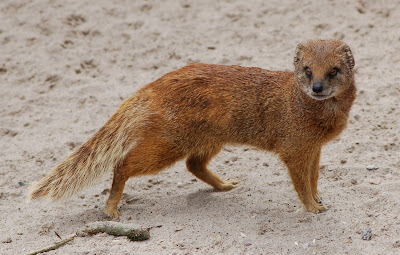 |
| Mongoose HD Wallpapers |
 |
| Mongoose HD Wallpapers |
Mongoose
The mongoose is a small rodent-like mammal, the mongoose is similar in appearance to the meerkat and the weasel. Mongoose are naturally found in Asia, Africa and parts of Europe but the mongoose has also been artificially introduced to the Caribbean in more recent times.
The mongoose is an omnivore, meaning that mongoose eat both plants and animals. The mongoose in Africa has caught the attention of humans, as they appear to be almost immune the poison of a snake.
The mongoose is slightly lighter than the weasel, meaning that the mongoose is able to avert danger more readily than a weasel as a mongoose is able to see oncoming predators with greater ease.
There are thought to be around 30 different species of mongoose, some of which will only fend for themselves while other species of mongoose work together as a team. The different species of mongoose also vary in size ranging from less than 1 foot to nearly three foot in height.
Many species of mongoose have adapted to their particular habitat as some species of mongoose are found to live in the tops of trees where other species of mongoose have adapted to living partially in the water. A number of mongoose species are also known to have patterned fur or ringed tails, this however is not the case with every species of mongoose.
The typical mongoose has a long-shaped face and body, short legs and little round ears. Many mongoose individuals are found living in burrows which the mongoose tend to dig themselves, the mongoose however, will not pass up the opportunity to hide in an abandoned burrow of another small animal.
The female mongoose tends to produce only one litter of pups a year, but she is able to produce another litter if for some reason, the first litter is lost. The young mongooses are weaned at around 6 weeks old, and the baby mongooses then begin to forage with their mother until they are 4 months old. The male mongoose babies will leave their mother when they are around 6 months old, while the female mongoose babies will stay longer, sometimes even permanently.
Mosgoose Description
The body of the Mongoose is roundish and a dark brown color. They have lighter brown around the face. They feature a small nose and very small ears. They have a bushy tail and very small paws with sharp claws on them. The coat is brindles and it is very thick.
Mosgoose Distribution
Africa is the location where you will find the largest number of Mongoose living. They are also found living in Asia, Europe and Hawaii. They create burrows under the ground where they live. They can create elaborate tunnels under the ground. Each of them will have several entrances and exits that enables the Mongoose to escape from danger. They will also take over burrows that other animals have abandoned.
Mosgoose Behavior
Sometimes you will see the Mongoose living alone. Others though live in groups and seem to enjoy that socialization that it offers. When they live in groups they create a hierarchy with a dominant male and dominant female. The advantage to living in a group is protection.
The Mongoose will take turns watching out for predators and other problems. If there is any problem they will give out loud calls and whistles. This allows all of the group to immediate get underground until the danger has passed. The guard duty rotates every 45 minutes to 1 hour. They often stand up on their hind legs and use their tail for balance. This allows them to look all around and to be alert to problems in their environment.
Mosgoose Feeding
When a Mongoose lives alone it has to get all of its own food. When it is part of a group though they will share what they find and spread it around for all to feed from. They feed on small mammals including various invertebrates. They also eat small types of birds. Insects, crabs, rodents, lizards, and snakes are all items that they eat. It depends on their location and their opportunities.
It is believed that the Mongoose isn’t affected though by venom that various prey including snakes offer. This means they can dine on food resources that would be classified as too dangerous for other types of animals to feed upon.
Mosgoose Reproduction
Mating can occur during any time of the year as long as the Mongoose has enough food and habitat. Giggling is used for a pair to find each other and they will court and then mate. It is common for pairs to mate with each other year after year.
The female will carry the young in her body for several weeks. When they emerge they will be born in burrow. They are blind and helpless for about 10 days. She will keep them warm, safe, and feed them milk from her body. They will come out of the burrow when they are several weeks old.
Many of the females will work together to care for the needs of the young. They create a very similar structure to a human nursery or daycare setting. The young will learn a great deal from the older juveniles. This includes digging, finding food, and being on the alert to danger. They are very playful and the young often create strong bonds with their mothers. They will stay close even after they are mature.





.jpg)
.jpg)

.jpg)
.JPEG)
.jpg)


.jpg)
